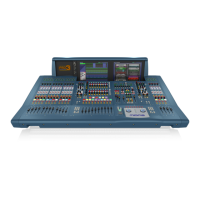48 Chapter 5: Before You Start
PRO Series Live Audio Systems
Owner’s Manual
Operating the top output fast strips from the master bay
During normal operation, both rows of output fast strips — which are always
independent from each other — are operated using the controls in the mix bay.
However, you can assign the master bay to control the top row of output strips.
>> To switch control of the output strips to the master bay
Press the right arrow (to right channel) button (see Figure 12 “Output channel
navigational controls” on page 66).
Controlling the mix buses in flip mode
Flip provides a more global approach to mix bus level control. Normally, you can only
use the level control knobs in the channel strips to adjust the signal level of the
aux/matrix mix buses going to the aux/matrix channels. However, by using flip you
have the option of controlling them from either the pan control knobs or the faders in
the input fast strips.
In flip mode the left/right arrow buttons in the upper channel select section scroll
across the input fast strips.
>> To configure the control centre for pan or fader flip
1 At the GUI, choose homePreferencesGeneral.
2 Depending on which option you require, click the option button of one of the
following in the Fader flip section. When an option is selected, it will contain a
red circle:
• “Flip to faders”.
• “Flip to Pans”.
>> To flip mixes to input pan/fader control
With an output selected on the control surface, press FLIP (see Figure 11 “Mix bus
navigational controls” on page 64). The button will illuminate to show you are in ‘flip’
mode. The currently selected mix bus in the input fast strips will change to AuxS1 and,
on the GUI, the background colour of the pans and faders will change accordingly.
Also, the LCD select buttons in the input fast strips will display the current bus mode,
for example, “MONO AUX”.
Hints and tips
• Check what is hidden On the control centre, unlike on an analogue control
surface, some of the settings and parameters will be hidden from view (stored in the
computer memory of the control centre). At various times during a mix we
recommend that you select and view unused parameters to make sure there are no
hidden surprises, for example, a reverb send left from a previous mix.
• Check the Meters screen It is a good idea to frequently monitor the Meters
screen (default display of the master bay GUI), which provides at a glance an
overview of the control centre’s status and operation. It shows all the meters and
the status condition of faders and some switches, such as solos and mutes.
However, some things will still remain hidden.

